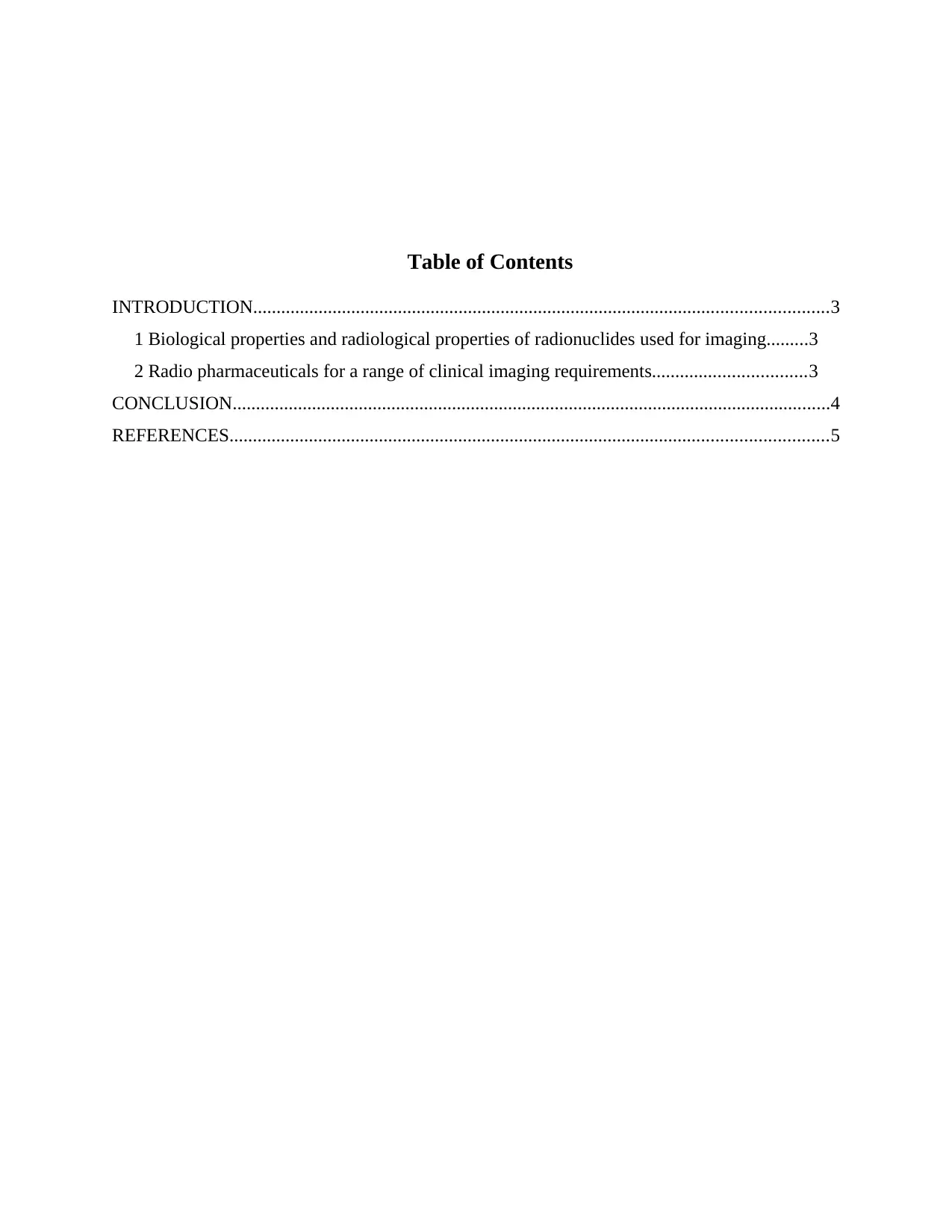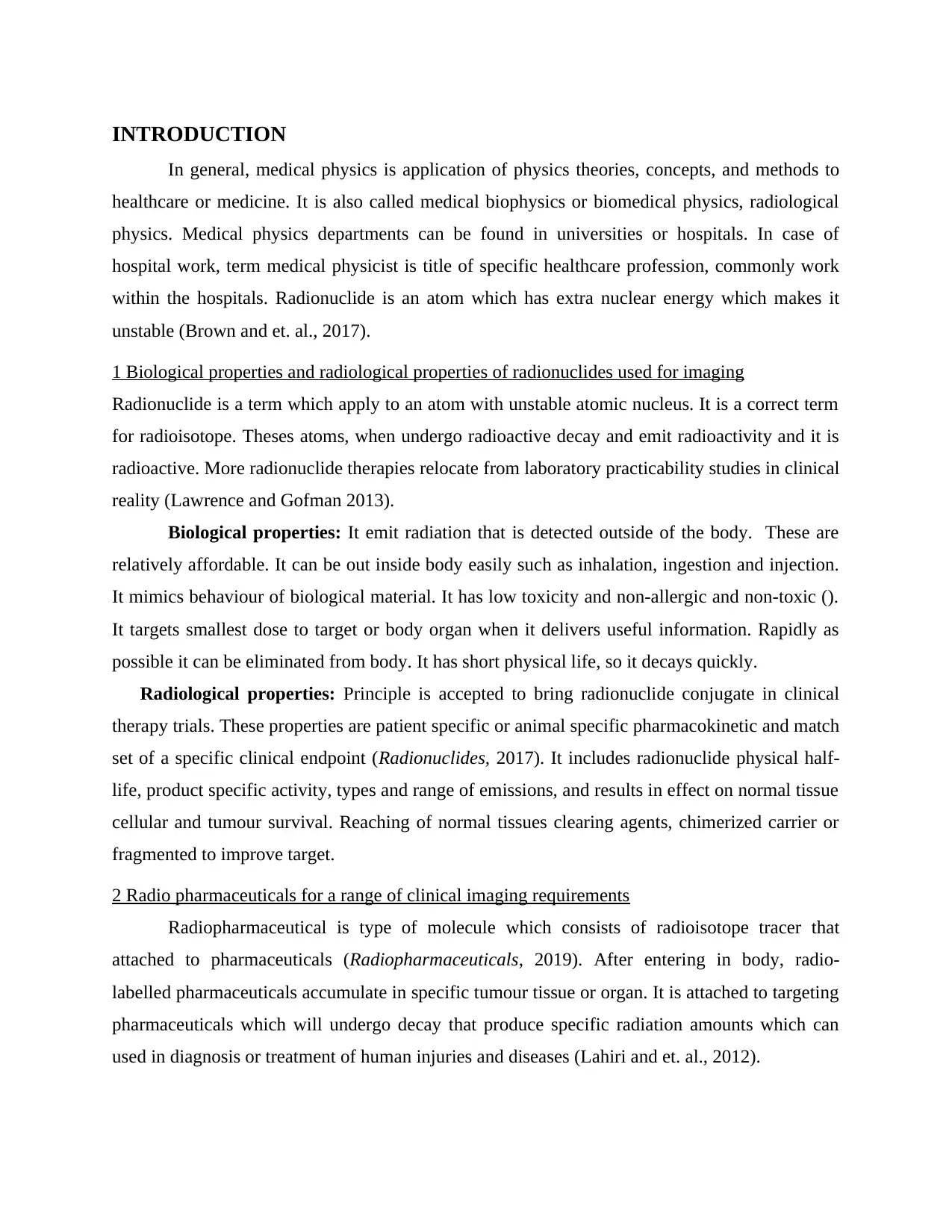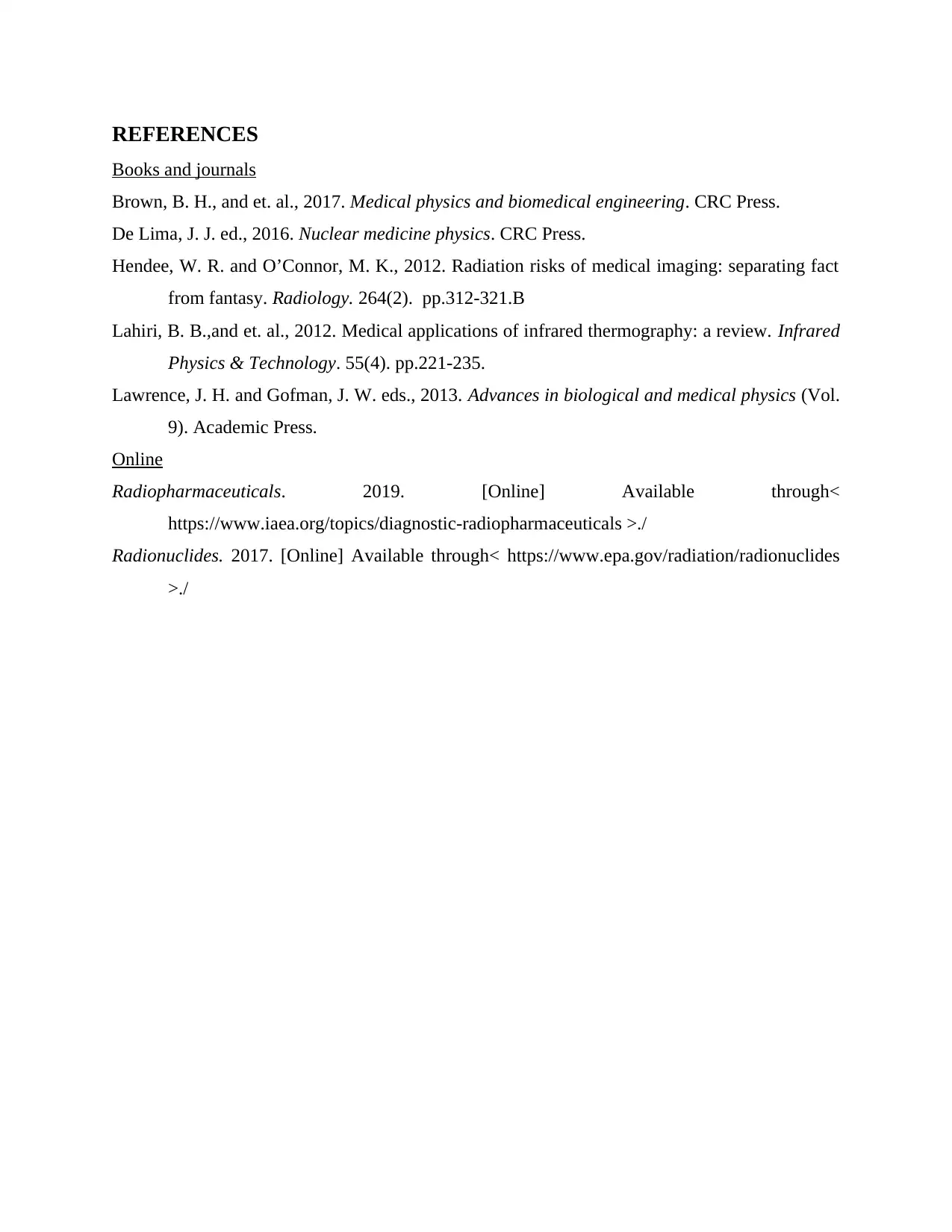Radionuclides and Radiopharmaceuticals in Medical Physics Report
VerifiedAdded on 2021/01/03
|6
|821
|370
Report
AI Summary
This report provides an overview of medical physics, focusing on the biological and radiological properties of radionuclides and their applications in clinical imaging. It explores the characteristics of radionuclides, including their stability and decay processes. The report further examines various radiopharmaceuticals, such as Technetium-99m and Iodine-131, detailing their uses in different imaging modalities like cerebral perfusion, pulmonary perfusion, bone imaging, thyroid, and salivary gland imaging. It discusses the advantages and disadvantages of different radioisotopes, emphasizing their half-lives and emission types. The report concludes by highlighting the importance of these technologies in healthcare for diagnosis and treatment, referencing key literature in the field.

MEDICAL PHYSICS
Paraphrase This Document
Need a fresh take? Get an instant paraphrase of this document with our AI Paraphraser

Table of Contents
INTRODUCTION...........................................................................................................................3
1 Biological properties and radiological properties of radionuclides used for imaging.........3
2 Radio pharmaceuticals for a range of clinical imaging requirements.................................3
CONCLUSION................................................................................................................................4
REFERENCES................................................................................................................................5
INTRODUCTION...........................................................................................................................3
1 Biological properties and radiological properties of radionuclides used for imaging.........3
2 Radio pharmaceuticals for a range of clinical imaging requirements.................................3
CONCLUSION................................................................................................................................4
REFERENCES................................................................................................................................5

INTRODUCTION
In general, medical physics is application of physics theories, concepts, and methods to
healthcare or medicine. It is also called medical biophysics or biomedical physics, radiological
physics. Medical physics departments can be found in universities or hospitals. In case of
hospital work, term medical physicist is title of specific healthcare profession, commonly work
within the hospitals. Radionuclide is an atom which has extra nuclear energy which makes it
unstable (Brown and et. al., 2017).
1 Biological properties and radiological properties of radionuclides used for imaging
Radionuclide is a term which apply to an atom with unstable atomic nucleus. It is a correct term
for radioisotope. Theses atoms, when undergo radioactive decay and emit radioactivity and it is
radioactive. More radionuclide therapies relocate from laboratory practicability studies in clinical
reality (Lawrence and Gofman 2013).
Biological properties: It emit radiation that is detected outside of the body. These are
relatively affordable. It can be out inside body easily such as inhalation, ingestion and injection.
It mimics behaviour of biological material. It has low toxicity and non-allergic and non-toxic ().
It targets smallest dose to target or body organ when it delivers useful information. Rapidly as
possible it can be eliminated from body. It has short physical life, so it decays quickly.
Radiological properties: Principle is accepted to bring radionuclide conjugate in clinical
therapy trials. These properties are patient specific or animal specific pharmacokinetic and match
set of a specific clinical endpoint (Radionuclides, 2017). It includes radionuclide physical half-
life, product specific activity, types and range of emissions, and results in effect on normal tissue
cellular and tumour survival. Reaching of normal tissues clearing agents, chimerized carrier or
fragmented to improve target.
2 Radio pharmaceuticals for a range of clinical imaging requirements
Radiopharmaceutical is type of molecule which consists of radioisotope tracer that
attached to pharmaceuticals (Radiopharmaceuticals, 2019). After entering in body, radio-
labelled pharmaceuticals accumulate in specific tumour tissue or organ. It is attached to targeting
pharmaceuticals which will undergo decay that produce specific radiation amounts which can
used in diagnosis or treatment of human injuries and diseases (Lahiri and et. al., 2012).
In general, medical physics is application of physics theories, concepts, and methods to
healthcare or medicine. It is also called medical biophysics or biomedical physics, radiological
physics. Medical physics departments can be found in universities or hospitals. In case of
hospital work, term medical physicist is title of specific healthcare profession, commonly work
within the hospitals. Radionuclide is an atom which has extra nuclear energy which makes it
unstable (Brown and et. al., 2017).
1 Biological properties and radiological properties of radionuclides used for imaging
Radionuclide is a term which apply to an atom with unstable atomic nucleus. It is a correct term
for radioisotope. Theses atoms, when undergo radioactive decay and emit radioactivity and it is
radioactive. More radionuclide therapies relocate from laboratory practicability studies in clinical
reality (Lawrence and Gofman 2013).
Biological properties: It emit radiation that is detected outside of the body. These are
relatively affordable. It can be out inside body easily such as inhalation, ingestion and injection.
It mimics behaviour of biological material. It has low toxicity and non-allergic and non-toxic ().
It targets smallest dose to target or body organ when it delivers useful information. Rapidly as
possible it can be eliminated from body. It has short physical life, so it decays quickly.
Radiological properties: Principle is accepted to bring radionuclide conjugate in clinical
therapy trials. These properties are patient specific or animal specific pharmacokinetic and match
set of a specific clinical endpoint (Radionuclides, 2017). It includes radionuclide physical half-
life, product specific activity, types and range of emissions, and results in effect on normal tissue
cellular and tumour survival. Reaching of normal tissues clearing agents, chimerized carrier or
fragmented to improve target.
2 Radio pharmaceuticals for a range of clinical imaging requirements
Radiopharmaceutical is type of molecule which consists of radioisotope tracer that
attached to pharmaceuticals (Radiopharmaceuticals, 2019). After entering in body, radio-
labelled pharmaceuticals accumulate in specific tumour tissue or organ. It is attached to targeting
pharmaceuticals which will undergo decay that produce specific radiation amounts which can
used in diagnosis or treatment of human injuries and diseases (Lahiri and et. al., 2012).
⊘ This is a preview!⊘
Do you want full access?
Subscribe today to unlock all pages.

Trusted by 1+ million students worldwide

Technetium 99m Tc: It possesses relatively short half life that is of 6 hours. And it allows
establishment of higher activity amounts for clear and faster images during exposing patient to
low radiation dose. And also it offers bulk amount of gamma photons for the imaging (De Lima
2016).
99mTc exametazime- It is a type of radio labelling which used in cerebral perfusion.
99mTcmacroaggregated albumin- It is mainly used in pulmonary perfusion.
99mTcmedronate- It helps in bone imaging.
99mTcpertechnetate- It performed for thyroid salivary glands imaging.
99mTcsulfrcolloid- it used to image reticule.
Iodine-131: It is produced by OPAL. It has half life time of 8 days. It is used to treat thyroid
cancer. Iodine- 123 is preferred more than iodine-131 because it emits only gamma rays. It has
13 hours half life of period. But only thing is it is quite expensive (Hendee and O’Connor 2012).
CONCLUSION
In medical physics consists theories and concepts of healthcare. There are biological and
radiological properties of radionuclide. And different rages of clinical imaging like 99m Tc,
iodine-123 and iodine- 131 is mostly used in radio pharmaceuticals.
establishment of higher activity amounts for clear and faster images during exposing patient to
low radiation dose. And also it offers bulk amount of gamma photons for the imaging (De Lima
2016).
99mTc exametazime- It is a type of radio labelling which used in cerebral perfusion.
99mTcmacroaggregated albumin- It is mainly used in pulmonary perfusion.
99mTcmedronate- It helps in bone imaging.
99mTcpertechnetate- It performed for thyroid salivary glands imaging.
99mTcsulfrcolloid- it used to image reticule.
Iodine-131: It is produced by OPAL. It has half life time of 8 days. It is used to treat thyroid
cancer. Iodine- 123 is preferred more than iodine-131 because it emits only gamma rays. It has
13 hours half life of period. But only thing is it is quite expensive (Hendee and O’Connor 2012).
CONCLUSION
In medical physics consists theories and concepts of healthcare. There are biological and
radiological properties of radionuclide. And different rages of clinical imaging like 99m Tc,
iodine-123 and iodine- 131 is mostly used in radio pharmaceuticals.
Paraphrase This Document
Need a fresh take? Get an instant paraphrase of this document with our AI Paraphraser

REFERENCES
Books and journals
Brown, B. H., and et. al., 2017. Medical physics and biomedical engineering. CRC Press.
De Lima, J. J. ed., 2016. Nuclear medicine physics. CRC Press.
Hendee, W. R. and O’Connor, M. K., 2012. Radiation risks of medical imaging: separating fact
from fantasy. Radiology. 264(2). pp.312-321.B
Lahiri, B. B.,and et. al., 2012. Medical applications of infrared thermography: a review. Infrared
Physics & Technology. 55(4). pp.221-235.
Lawrence, J. H. and Gofman, J. W. eds., 2013. Advances in biological and medical physics (Vol.
9). Academic Press.
Online
Radiopharmaceuticals. 2019. [Online] Available through<
https://www.iaea.org/topics/diagnostic-radiopharmaceuticals >./
Radionuclides. 2017. [Online] Available through< https://www.epa.gov/radiation/radionuclides
>./
Books and journals
Brown, B. H., and et. al., 2017. Medical physics and biomedical engineering. CRC Press.
De Lima, J. J. ed., 2016. Nuclear medicine physics. CRC Press.
Hendee, W. R. and O’Connor, M. K., 2012. Radiation risks of medical imaging: separating fact
from fantasy. Radiology. 264(2). pp.312-321.B
Lahiri, B. B.,and et. al., 2012. Medical applications of infrared thermography: a review. Infrared
Physics & Technology. 55(4). pp.221-235.
Lawrence, J. H. and Gofman, J. W. eds., 2013. Advances in biological and medical physics (Vol.
9). Academic Press.
Online
Radiopharmaceuticals. 2019. [Online] Available through<
https://www.iaea.org/topics/diagnostic-radiopharmaceuticals >./
Radionuclides. 2017. [Online] Available through< https://www.epa.gov/radiation/radionuclides
>./

⊘ This is a preview!⊘
Do you want full access?
Subscribe today to unlock all pages.

Trusted by 1+ million students worldwide
1 out of 6
Related Documents
Your All-in-One AI-Powered Toolkit for Academic Success.
+13062052269
info@desklib.com
Available 24*7 on WhatsApp / Email
![[object Object]](/_next/static/media/star-bottom.7253800d.svg)
Unlock your academic potential
Copyright © 2020–2025 A2Z Services. All Rights Reserved. Developed and managed by ZUCOL.




